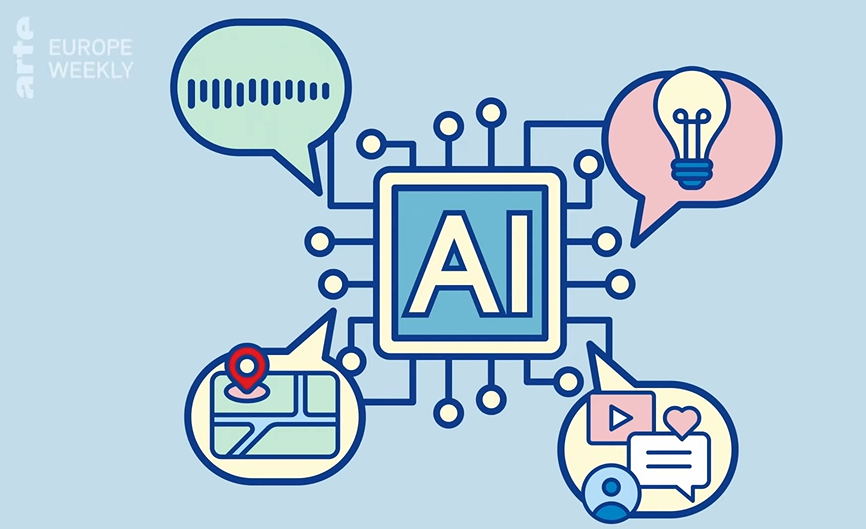While China is already developing more efficient AI models, Europe remains behind the US paradigm of technical progress.
Have the United States initiated a race for artificial intelligence in which Europe can only lose? From the outside, it appeared that way, at least for a brief period. Last week, Donald Trump promised a $500 billion AI infrastructure initiative. Only one week later, such investments in AI infrastructure look unwise. Even Europe’s grandest intentions pale in contrast to the billions invested in the previous two years by both Trump and internet corporations.
Last year, for example, the EU Commission approved a three-billion-euro innovation package for AI startups and SMEs. An extremely little sum. Even the $800 billion that former EU central banker and euro savior Mario Draghi intends to mobilize yearly for Europe’s competitiveness make the EU appear slow and unambitious. After all, the funds are intended to be spent across a wide range of businesses and will only be available with the new EU budget in 2028. How can cumbersome and bureaucratic Europe compete in an AI race against the United States?
However, looks are misleading. There are some difficult facts underlying Trump’s public relations offensive: Trump’s reported investment is entirely private, rather than state-sponsored. The finance has not yet been completed. The funding revealed thus far come from SoftBank and OpenAI, and much of it is just hot air. SoftBank announced investments of $100 billion a month ago. According to Elon Musk, the actual pledges are likely closer to 10 billion. The Financial Times claimed over the weekend that the plan would only benefit OpenAI.
The staging was a triumph for both the US AI sector and the Trump administration. AI is proclaimed a key priority, portraying it as “too big to fail” and “too important to slow down”. All of this occurs while the economic sustainability of massive language models is unknown. OpenAI, the world’s leading revenue player, continues to lose money. Nonetheless, Trump may present an image of massive investments and several new employment. It is unknown how they will be generated, or whether AI will be used mostly to reduce jobs.
Perhaps more concerning than the government’s anticipated antics is Europe’s reflexive reaction: panic, anxiety, and a genuine dread of losing out. With AI firm stocks plummeting, that response is even more wrong than it was before. Europe is definitely straining to stay up with the global drive to develop ever-larger AI models. However, the more crucial question is whether it should even attempt.
The assumption that the world is in an AI race is based on a simple equation: increased computer power results in better models, which contribute to economic and societal advancement. However, the truth is different. Signs of an AI bubble have been growing for months. The major models do not yet have a reliable business model. At the same time, Chinese businesses are building competing models such as DeepSeek with far fewer resources.
European corporations have long gone their own way. They are departing from the strictly defined route of the US behemoths and pursuing novel niches. “Anyone can spend an unlimited amount of money on Nvidia chips, but finding a viable business model is much more difficult,” Aleph Alpha CEO Jonas Andrulis recently told the German government’s digital conference.
The EU should avoid investing foolishly on AI infrastructure for ever-larger AI models. Because a lack of funds is only half of the issue. The main obstacles are the oligopolies of the US tech behemoths: Alphabet, Amazon, Apple, Meta, Microsoft, Nvidia, and X. They can invest billions of dollars on AI, often without a viable business plan. US businesses dominate Europe’s cloud industry, giving them control of critical AI infrastructure. Nvidia, a US corporation, supplies practically all of the processors that European AI startups rely on, at exorbitant pricing and with rapid value loss. European dependency is so significant that US administrations may politically block supply at any time, as Poland discovered under US President Joe Biden.
If Europe were to spend billions of euros in the extremely concentrated global AI sector, the majority of the funding would go to Nvidia (for processors) and Amazon, Google, and Microsoft (for cloud computing). In Europe, there is a lack of understanding that the rapid price hikes in the AI business are mostly due to a few US companies. These prices have now dropped.
Europe’s economy must awaken from its slumber. However, as Biden warns in the latter days of his tenure about the threats that the oligarchy poses to US democracy, Europe continues to pursue a paradigm that no longer works for the majority of the US population. The question is whether spending billions in a highly concentrated market would result in the type of prosperity we seek: equitably distributed, ecologically benign, and consistent with Europe’s social model. Under what conditions should such large-scale public investments be made? These questions remain unanswered.
A fundamental strategy for Europe’s digital future is required. What type of digital future do Europeans want? What role should artificial intelligence play in this scenario? Who will help mold this future? A first step: eventually establish fair competitive conditions. Instead of promoting market concentration, public funding should be used to break it up. This demands political fortitude, even in the face of potential US reprisal. Finally, Europe must foster an innovation climate in which new ideas may survive and evolve, such as models that demand far fewer resources and computer power. Investing billions on AI infrastructure is a handy but ultimately damaging strategy that reinforces the status quo. This hurts Europe’s interests.
The author, Frederike Kaltheuner, is the Senior Lead for Europe and Global Governance at the AI Now Institute, a policy research think tank in New York.









+ There are no comments
Add yours